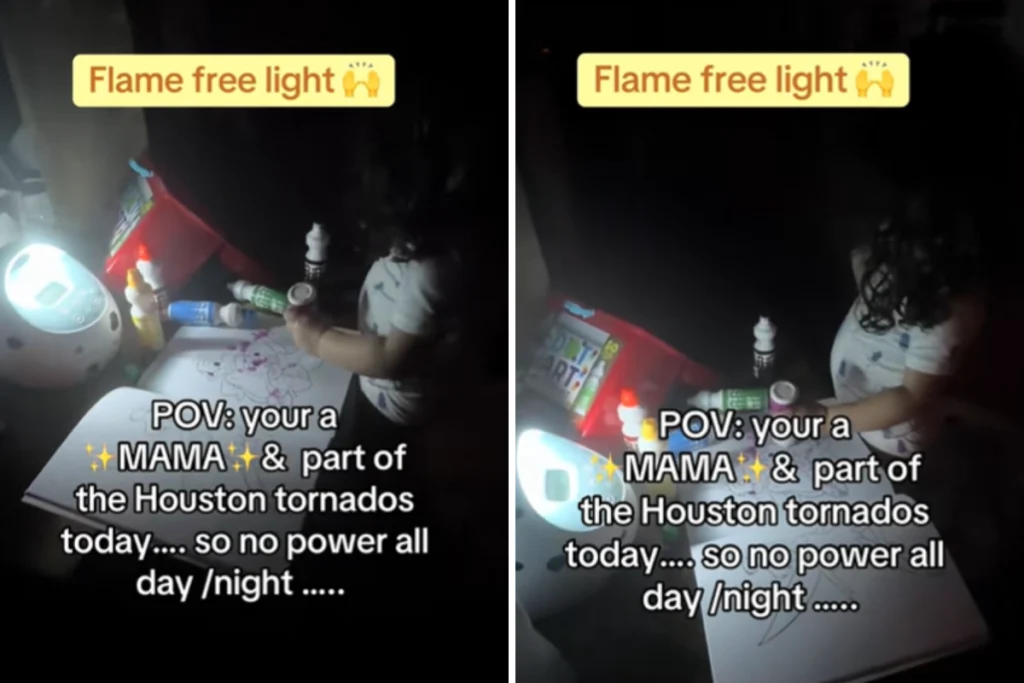Houston Mom’s Creative Solution During Tornado Power Outage
In the midst of an unexpected tornado that swept through Houston, one mother’s resourceful thinking turned what could have been a frightening experience for her children into a moment of normalcy and creativity. Sarah Tischler, a mother of three young children, found herself suddenly plunged into darkness when a tornado touched down in her neighborhood, cutting power to her home for nearly twelve hours. Rather than succumbing to panic, Sarah’s quick thinking and maternal instinct led to an innovative solution that later captured hearts across social media. Using the LED light from her breast pump, she created a makeshift lamp that allowed her two-year-old daughter, Izabelle, to continue coloring and playing despite the emergency situation unfolding around them. This simple act of motherly ingenuity—making the best of challenging circumstances to maintain a sense of calm for her children—resonated with parents everywhere when Sarah later shared the moment on TikTok.
The tornado arrived with little warning, catching many Houston residents off guard, including the Tischler family. Sarah had received a casual heads-up from her own mother suggesting they take shelter in their guest bathroom, but like many who live in areas where weather warnings are common, she initially didn’t think much of it. “I didn’t take it seriously because we do get a lot of wind warnings, but never a tornado,” Sarah explained. That changed moments later when her phone buzzed with an official alert, leaving barely minutes before the tornado touched down directly in their neighborhood. Though the Tischlers’ home was fortunately spared significant damage, streets just blocks away weren’t as lucky. The tornado cut a visible path of destruction through familiar areas, adding another layer of trauma for a community that had already endured significant damage from Hurricane Beryl just the previous year. The suddenness of the event underscores how quickly ordinary days can transform into emergencies, particularly in regions increasingly affected by extreme weather events.
What followed was a demonstration of community resilience that seems increasingly common in American neighborhoods hit by natural disasters. As soon as it was safe to venture outside, neighbors began helping one another—cutting fallen trees, clearing debris, and checking on vulnerable residents. This immediate response happened even as the entire neighborhood remained without power from early afternoon until nearly midnight. For the Tischlers, with three children under age four—eight-month-old Lucas, two-year-old Izabelle, and four-year-old Noah—the extended power outage presented unique challenges. “We try to do as much screen-free time anyway… [but] it’s constant entertaining over here,” Sarah noted, highlighting the reality that modern parents often face when the electronic babysitters suddenly become unavailable. Her solution merged safety concerns with practicality: traditional candles weren’t an option with curious toddlers, but the breast pump’s gentle illumination provided just enough light for activities while posing no fire hazard.
The children’s responses to the unusual situation revealed the remarkable adaptability of young minds when guided by calm parental presence. Two-year-old Izabelle, whom Sarah’s partner Jake affectionately nicknamed “glitter tornado” for her typically energetic and messy creative play, contentedly focused on her dot markers under the soft glow of the breast pump light. Meanwhile, four-year-old Noah transformed a simple flashlight into an impromptu shadow puppet theater, creating entertainment that kept his siblings laughing despite the darkness surrounding them. These moments of childhood joy amid what could have been a frightening situation speak to how children often take their emotional cues from adults around them. Rather than absorbing panic or stress, the Tischler children experienced the power outage as simply another opportunity for creative play—a testament to their parents’ composed approach to the emergency.
When electricity was finally restored just before midnight, the family’s challenges weren’t entirely over. With emergency crews, utility workers, and news media flooding their neighborhood to document the unusual tornado touchdown in Houston, residents were encouraged to stay home to keep roads clear. “There was a lot of media attention to the neighborhood with everything going on and how unusual it is in Houston and emergency crews needed priority on the road,” Sarah explained. This aspect of natural disasters—the aftermath period when recovery efforts and public interest intersect—often creates a secondary layer of disruption for affected families trying to return to normal routines. The Tischler family’s experience highlights how modern weather emergencies unfold not just in physical space but also in media coverage and community response systems, creating complex situations for families to navigate beyond the immediate safety concerns.
Perhaps most remarkable about Sarah’s story is her matter-of-fact attitude toward the entire experience. “The power has so far stayed on since the tornado, but our neighborhood loses power left and right with all the older trees we have, so it’s just another day in the life for us,” she reflected. This perspective reveals how many families, particularly in regions prone to weather disruptions, develop resilience through repeated exposure to similar challenges. For the Tischlers, having weathered Hurricane Beryl previously and living in an area where power outages are relatively common due to aging infrastructure and mature trees, the tornado response became an extension of skills they’d already developed. Sarah’s breast pump lighting solution wasn’t a flash of brilliance in crisis but rather the natural thinking of a mother who has learned to problem-solve on the fly—turning everyday parenting objects into multi-purpose tools when needed. In sharing this moment online, she provided not just a heartwarming glimpse into family adaptation during crisis, but also a subtle reminder that parental ingenuity often thrives precisely when normal routines are disrupted.


